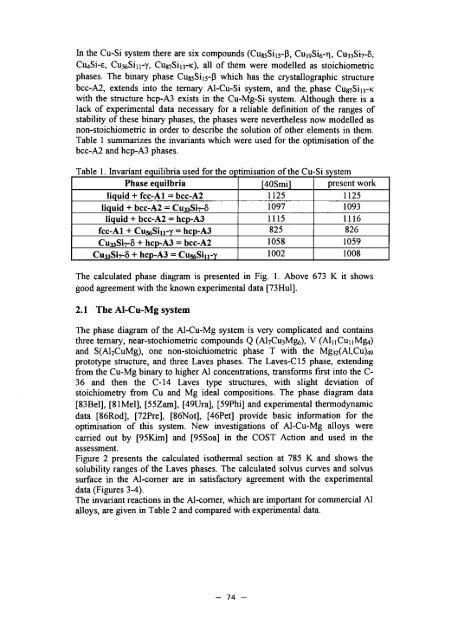COST 507 - Repositório Aberto da Universidade do Porto
COST 507 - Repositório Aberto da Universidade do Porto
COST 507 - Repositório Aberto da Universidade do Porto
You also want an ePaper? Increase the reach of your titles
YUMPU automatically turns print PDFs into web optimized ePapers that Google loves.
In the CuSi system there are six compounds (Cu&Siisß, CuigSiôri, Cu 33 Si78,<br />
CujSiε, CusóSiiiy, Q^SÍBK), all of them were modelled as stoichiometric<br />
phases. The binary phase CugsSiisß which has the crystallographic structure<br />
bccA2, extends into the ternary AlCuSi system, and the. phase Q^Si^tc<br />
with the structure hcpA3 exists in the CuMgSi system. Although there is a<br />
lack of experimental <strong>da</strong>ta necessary for a reliable definition of the ranges of<br />
stability of these binary phases, the phases were nevertheless now modelled as<br />
nonstoichiometric in order to describe the solution of other elements in them.<br />
Table 1 summarizes the invariants which were used for the optimisation of the<br />
bccA2 and hcpA3 phases.<br />
Table 1. Invariant equilibria used for the optimisation of the CuSi system<br />
Phase equilbria<br />
liquid + fcc-Al = bccA2<br />
liquid + bccA2 = Cu33S¡78<br />
liquid + bccA2 = hcpA3<br />
fccAl + CuseSinY = hcpA3<br />
Cu33SÍ7ô + hcpA3 = bccA2<br />
Cu33Sirô + hcpA3 = CuseSiiiy<br />
í40Smil<br />
1125<br />
1097<br />
1115<br />
825<br />
1058<br />
1002<br />
present work<br />
1125<br />
1093<br />
1116<br />
826<br />
1059<br />
1008<br />
The calculated phase diagram is presented in Fig. 1. Above 673 K it shows<br />
good agreement with the known experimental <strong>da</strong>ta [73Hul].<br />
2.1 The Al-Cu-Mg system<br />
The phase diagram of the AlCuMg system is very complicated and contains<br />
three ternary, nearstochiometric compounds Q (AF/C^Mgö), V (AlnCunMgi)<br />
and S(Al2CuMg), one nonstoichiometric phase T with the Mg 32 (Al,Cu)49<br />
prototype structure, and three Laves phases. The LavesC15 phase, extending<br />
from the CuMg binary to higher Al concentrations, transforms first into the C<br />
36 and then the C14 Laves type structures, with slight deviation of<br />
stoichiometry from Cu and Mg ideal compositions. The phase diagram <strong>da</strong>ta<br />
[83Bel], [81Mel], [55Zam], [49Ura], [59Phi] and experimental thermodynamic<br />
<strong>da</strong>ta [86Rod], [72Pre], [86Not], [46Pet] provide basic information for the<br />
optimisation of this system. New investigations of AlCuMg alloys were<br />
carried out by [95Kim] and [95Soa] in the <strong>COST</strong> Action and used in the<br />
assessment.<br />
Figure 2 presents the calculated isothermal section at 785 K and shows the<br />
solubility ranges of the Laves phases. The calculated solvus curves and solvus<br />
surface in the Alcomer are in satisfactory agreement with the experimental<br />
<strong>da</strong>ta (Figures 34).<br />
The invariant reactions in the Alcomer, which are important for commercial Al<br />
alloys, are given in Table 2 and compared with experimental <strong>da</strong>ta.<br />
74
















